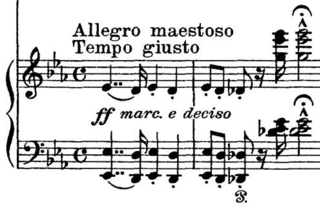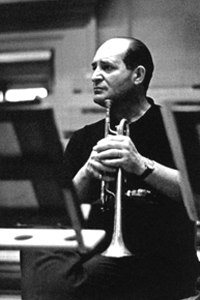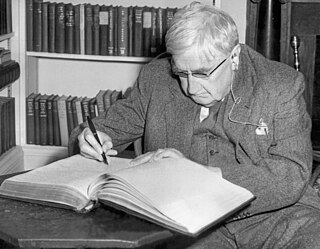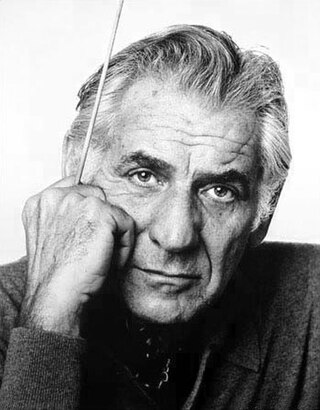
Sergei Prokofiev wrote his Symphony No. 2 in D minor, Op. 40, in Paris in 1924-25, during what he called "nine months of frenzied toil". He characterized this symphony as a work of "iron and steel".
Václav Nelhýbel was a Czech American composer, mainly of works for student performers.

Franz Liszt composed his Piano Concerto No. 1 in E♭ major, S.124 over a 26-year period; the main themes date from 1830, while the final version is dated 1849. The concerto consists of four movements and lasts approximately 20 minutes. It premiered in Weimar on February 17, 1855, with Liszt at the piano and Hector Berlioz conducting.

Roger Louis Voisin was an American classical trumpeter. In 1959, The New York Times called him "one of the best-known trumpeters in this country."
Polish composer Witold Lutosławski's Concerto for Orchestra was written in the years 1950–54, on the initiative of the artistic director of the Warsaw Philharmonic, Witold Rowicki, to whom it is dedicated. It is written in three movements, lasts about 30 minutes, and constitutes the last stage and a crowning achievement of the folkloristic style in Lutosławski's work. That style, inspired by the music of the Kurpie region, went back in time to the pre-1939 years. Having written a series of small folkloristic pieces for various instruments and their combinations, Lutosławski decided to use his experience of stylisation of Polish folklore in a bigger work. However, the Concerto for Orchestra differs from Lutosławski's earlier folkloristic pieces not only in that it is more extended, but also in that what is retained from folklore is only melodic themes. The composer moulds them into a different reality, lending them new harmony, adding atonal counterpoints, and turning them into neo-baroque forms.

Ralph Vaughan Williams's Symphony No. 8 in D minor was composed between 1953 and 1955. Sir John Barbirolli, its dedicatee, conducted the Hallé Orchestra in the premiere at the Kings Hall in Manchester, on 2 May 1956. It is the shortest of the composer's nine symphonies, and is mostly buoyant and optimistic in tone.
Souvenir des Ming is the title of Jeffrey Ching's Fourth Symphony, which was composed in London between 14 January and 29 June 2002, and is in a single large movement lasting about thirty-five minutes. There is a further parenthetical title, Passacaglia and Fugue on Ming dynasty Fragments, which describes the actual thematic content and form of the work. In China the work is known as Minglü huiyin 明律回音.

Symphony No. 6 is an orchestral work by Carlos Chávez, composed in 1961–62.

The Symphony No. 2 in E, Op. 40, was completed by Ernő Dohnányi in 1944, at the close of the Second World War. It was revised later in the 1950s. Written with audible roots in the Romantic tradition, the work is largely lyrical, yet maintains a controlled militaristic air inspired by the events surrounding its composition. It references a variety of musical backgrounds, including the work of Brahms, Wagner, Kabalevsky, and Bach. Bach's song Komm, süßer Tod serves as the basis for a significant portion of the finale.
Russell Peck was an American composer born in Detroit on January 25, 1945 to Thorland (Tom) and Margaret (Carlson) Peck. He died in Greensboro, North Carolina on March 1, 2009, at the age of 64.
The Suite of Symphonies for brass, strings & timpani No. 1 is a composition by Jean-Joseph Mouret. The first movement of this piece, the rondeau, is widely known and commonly used in weddings, and notably on the PBS program Masterpiece. Mouret composed this piece in 1729, while being the director for the Concert Spirituel, which was one of the first concert series known in existence.

The Symphony No. 1 in F major, Op. 29, is a three-movement orchestral composition by the Finnish composer Leevi Madetoja, who wrote the piece from 1914–16 at the dawn of his professional career. Although late-Romantic in style, the symphony carefully eschews the extravagance and overindulgence typical of debut efforts, placing it among the most "mature" and restrained of first symphonies. Accordingly, the First is the shortest and most concentrated of Madetoja's three essays in the form and is the only one of his symphonies not to adhere to the traditional four-movement symphonic template.
Russian composer Alfred Schnittke's Symphony No. 7 was composed in 1993. It is dedicated to conductor Kurt Masur who gave its world premiere performance in New York with the New York Philharmonic Orchestra on 10 February 1994.

The Symphony No. 1 in G minor by Russian composer Vasily Kalinnikov was written from 1894 to 1895 and first published in 1900. The symphony is dedicated to Russian music critic and teacher Semyon Kruglikov.
William Walton's Variations on a Theme by Hindemith is an orchestral piece in eleven continuous sections, first performed in 1963. It is a tribute to Walton's friend and fellow composer Paul Hindemith.

The Symphony No. 1 is a four-movement orchestral composition by the Finnish composer Uuno Klami, who wrote the piece from 1937 to 1938. Georg Schnéevoigt and the Helsinki Philharmonic Orchestra premiered the work on 5 May 1939; later that year, Klami enlisted in the Finnish military and fought against the Soviet Union in the Winter War.

The Symphony No. 2 is a four-movement orchestral composition by the Finnish composer Uuno Klami, who wrote the piece from in 1945; it is the final of Klami's two numbered symphonies. Toivo Haapanen and the Helsinki Philharmonic Orchestra premiered the work at the Helsinki Conservatory on 15 December 1946.

Divertimento, or Divertimento for Orchestra, is a suite of eight orchestral bagatelles by American composer Leonard Bernstein. Completed in 1980 and written to celebrate the centenary of the Boston Symphony Orchestra, it is well-known for featuring the notes B and C in most of its melodic material.









